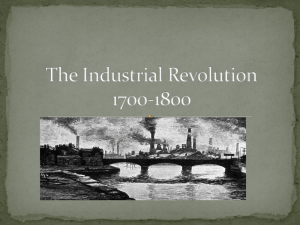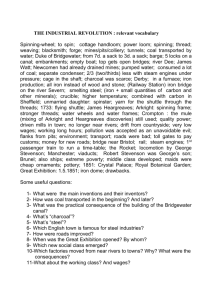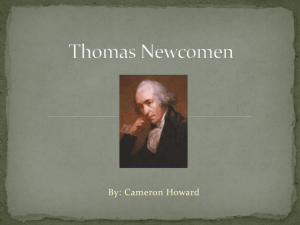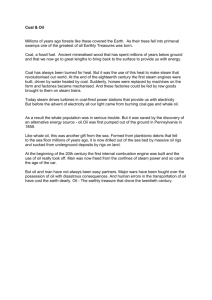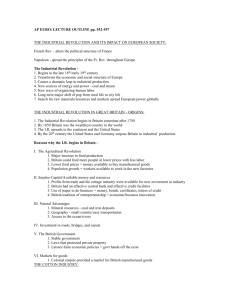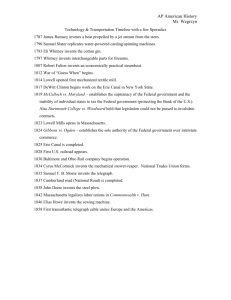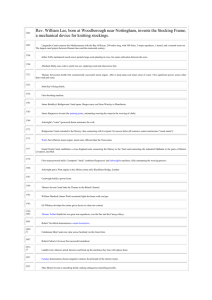The Industrial Revolution
advertisement
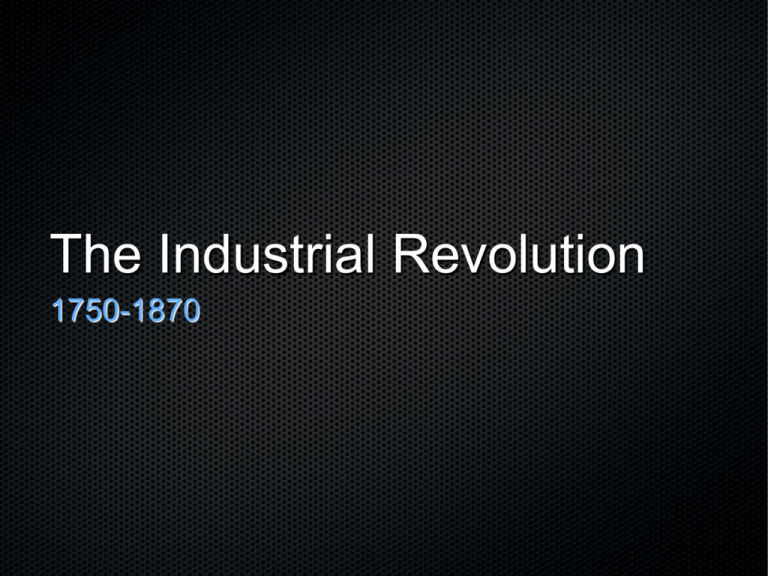
The Industrial Revolution 1750-1870 Chronology • 1712 Newcomen invents steam-operated water pump • 1733 Kay invents flying shuttle • • 1750-1800 Three million Africans brought to the Americas as enslaved workers 1760s Hargreaves invents spinning jenny, Watt imroves steam engine with separate condenser, Arkwright invents water frame • 1777 Watt and Arkwright build power loom • 1793 Whitney invents Cotton Gin • 1804 Jacquard invents automatic loom • 1831, 1834 Workers’ uprising in Lyon • 1832 Cholera epidemic • 1851 Majority of Britain’s population becomes urban The Industrial Revolution Defined change from an agricultural to an industrial society • • Eric Hobsbawn Age of Revolutions: 1789-1848 summarizes the change as: “The profundity of the revolution which broke out between 1789 and 1848 forms the greatest transformation in human history since the remote times when men invented agriculture and metallurgy, writing, the city and the state. The revolution has transformed, and continues to transform, the entire world.” Why did only Europe industrialize? 1. Legal due process made it illegal and unfamiliar for governments to seize wealth from its citizens • 2. Less of a disparity between rich and poor in Europe by comparison • 3. Public education led to higher rates of literacy • 4. Less pressure of overpopulation • 5. Competition between governments to outdo one another in trade and innovation created new ideas and capital to develop them followed. Transformations that accompanied the Industrial Era Agricultural transformations • farmers learned to use fertilizers and rotate crops • New crops helped boost production with the farming of maize and potatoes. • Farmers became wealthier and invested in produced cloth, iron plows and infrastructure such as better roads to transport goods. • More people were better fed leading to less infant mortality and boosted population Cottage industry system • Families would take in work and produce one piece of a finished product. • Created a work system based on specialization later the model for an industrial workforce. Scientific Inventions of the industrial Era • The Flying Shuttle - John Kay, made it possible to weave cotton cloth much more quickly • Spinning Jenny - invented by James Hargreaves in 1767 made greater yarn production possible: • water frame 1768 invented by Richard Arkwright made thread of greater strength • “mule” designed by Samuel Crompton in 1779 • 1792 - power loom invented by Edward Cartwright • • 1792 - Eli Whitney - Cotton gin removed seeds from harvested cotton mechanically rather than by hand. Coal as an alternative energy source • Charcoal depleted as a source of energy in Britain • 1708 Abraham Darby invented a “blast furnace” that separated the heat from the coal itself making it possible to use coal as an energy source for iron production. The Steam Engine • steam engine first devised by Newcomen in 1712 to pump water out of coal mines later improved by James Watt as an industrial machine. • 1777 the steam engine powered the blast furnace making iron production cheaper and much more efficient. • The necessity of machines made a demand for steel and iron. The need for steel and iron made a demand for coal to run machines to forge the steel and iron. The Railroad Social Changes • Increased social mobility • Urbanization • • Entire 18th century – London grew by 800,000 • 1800-1850 – London grew by 1.4 million New Industrial Working Class • creation of labor unions and labor laws Environmental Changes • Further depletion of forests • Soil erosion • Coal and iron mines created waste or “slag” • Ash dumped in rivers, soot released into the air • Carcinogenic fog Time Changed! Intellectual Reactions to Industrialism • Socialism • Marxism • Anarchism Socialist utopias Robert Owen Charles Fourier Count Saint Simon New Harmony, Indiana Marxism and Anarchism Mikhail Bakunin Karl Marx



